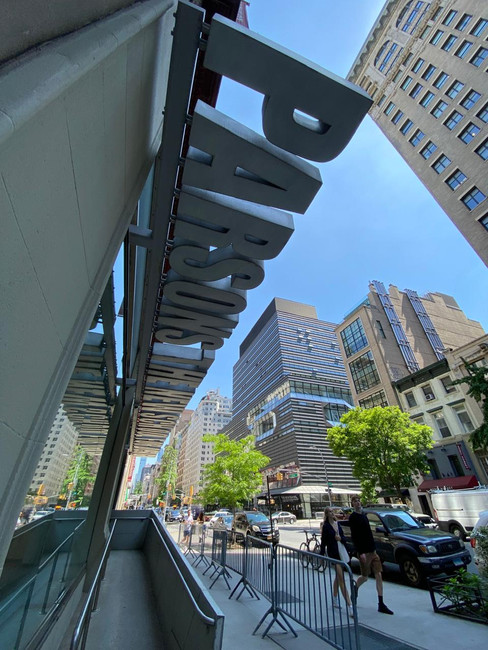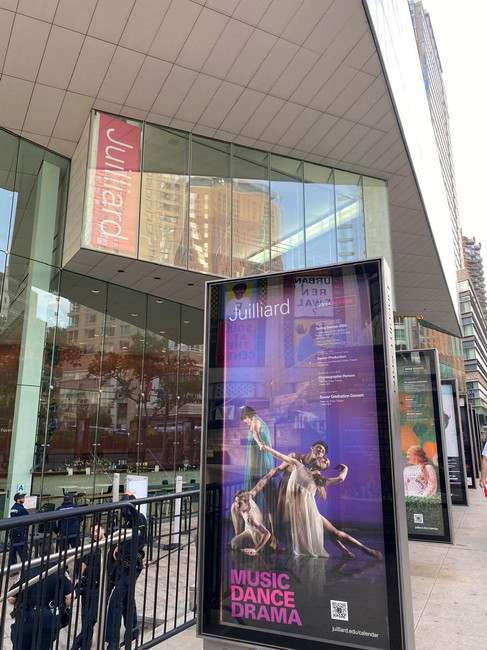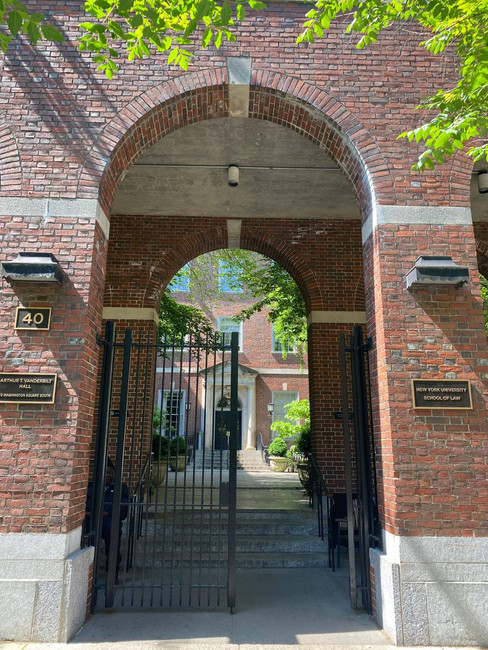
I recently spent 10 days in New York to attend my daughter’s graduation from Fordham University. Looking back on her four years refining critical reasoning and communication skills through the lens of whole-person learning, it also occurred to me that she gained incredibly valuable knowledge and experience from being a student in New York City.
This got me thinking about New York as an educational experience in and of itself. I regularly advise students to research academic programs and degrees, student life, and geographic location as they build their college lists. This visit to New York reinforced my belief that location impacts and shapes the college experience on so many levels. For Juliana, choosing New York to study film and tv made total sense as it is the home to major media companies, television networks, publishing houses, and digital media firms. In addition to her studies, she also interned at and a large media company and a creative marketing firm where she is now employed full time.
Consider the many roles NYC plays globally:
Financial Powerhouse: Home to Wall Street, the New York Stock Exchange, and numerous major financial institutions.
Corporate Headquarters: Many multinational corporations have their headquarters in NYC, influencing global business and trade.
Arts and Entertainment: NYC is a leading center for arts, theater, music, and fashion, boasting numerous museums, galleries, and cultural institutions like the Metropolitan Museum of Art, MoMA, and Lincoln Center.
Cultural Spectrum: The city welcomes people from all over the world, offering a rich tapestry of global cuisines, languages, and traditions. Journalism: NYC is a center for journalism, housing influential newspapers like The New York Times and The Wall Street Journal.
International Relations: The UN headquarters in NYC underscores the city’s role in international diplomacy and global affairs.
Tech Sector: NYC has become a burgeoning hub for startups and technology companies, fostering innovation and entrepreneurship.
A significant part of each of the above roles is education. Colleges and universities in NYC offer a tremendously diverse range of educational opportunities, including public, private, and religious institutions, student and faculty cohorts from across the US and around the world, world-class visual and performing arts programs, globally recognized degree programs, top research and STEM programs, and co-curricular partnerships with renowned cultural institutions and global industries.
Here is a list of universities with programs in the areas mentioned above, across a range of selectivity. This list is by no means exhaustive, but it might be a good starting point for someone wondering if NY is right for them.
For students considering a degree in business, finance, and related fields:
NYU Stern and Fordham Gabelli School are dedicated business schools with their own admission process.
Pace University was originally founded as a business school, and its flexible curriculum allows non-majors to take courses in the Lubin School of Business and earn even a Bloomberg certification.
Baruch College, part of the CUNY system, is home to the Zicklin School of Business.
While the Fashion Institute of Technology is a strong creative school, it also offers many programs related to entrepreneurship, marketing, and Fashion Business Management.
Columbia University also has a business concentration and combined programs.
For visual and performing arts:
The Juilliard School, The Ailey School, The New School, and Pratt are dedicated specifically to the arts.
The Cooper Union focuses mainly on art, architecture, and engineering.
The Tisch School at NYU has a vast range of creative programs from dramatic writing to interactive media.
For students looking for the foundational strength of a liberal arts program:
Barnard is a liberal arts college for women with strong foundational instruction across an array of lenses linking learning to contemporary issues.
Columbia is a research university with a rigid set of core requirements that unify its diverse undergraduate programs.
Fordham’s academic core is guided by its Jesuit mission, similar to Georgetown and Boston College.
Barnard, Columbia, Fordham and NYU are all top producers of Fullbright Scholars.
Fordham’s core requirements often have strong writing components, attractive to students wanting to hone their communication abilities. Their Communications and Media department offers degrees in digital technologies and emerging media, film and TV, and journalism, including coursework specific to sports broadcasting.
Be aware that many institutions silo the study of communications either to the business or visual arts realms. However, some institutions allow study across these academic divides. FIT offers many programs that require a multifaceted study, such as the BS in Cosmetics and Fragrance Marketing. The Gallatin School at NYU offers students a chance to create their own program of study.
Columbia’s film and journalism programs are very strong for postgraduate study. NYU’s film school is considered one of the best in the country. The Arthur L. Carter Journalism Institute is dedicated to international journalism.
For International Affairs:
Barnard offers a 4+1 program in conjunction with the Columbia School of International and Public Affairs.
NYU offers an MA in International Relations. Both schools also have options for international law as part of their JD programs.
Speaking of law, Fordham, Columbia, and NYU all have law schools. John Jay College of Criminal Justice is a CUNY school with undergraduate and professional degree programs.
NY can also satisfy students seeking engineering and STEM degrees. Columbia, NYU, NY Institute of Technology and The Cooper Union have engineering schools. Along with Columbia and NYU, robust STEM programs can be found a little outside NYC at Rutgers, Stevens Institute of Technology, and Stony Brook. The NY Institute of Technology has pathways in engineering for applicants who didn't have the opportunity to take calculus in high school. The campus for the Cornell partnership with the Jacobs Institute, home to innovative master’s programs in engineering and technology, is located on Roosevelt Island.
Again, this list doesn't scratch the surface of all the educational opportunities NYC has to offer from creative writing, to culinary arts, to cybersecurity, to cellular physiology.
Navigating NYC
NYC is globally connected by way of three major airports (JFK, LaGuardia, and Newark) facilitating travel and commerce. The city’s extensive public transportation system, including subways, buses, and commuter trains, makes it a critical transport hub. New York City proper is made up of five boroughs: Brooklyn, The Bronx, Manhattan, Queens, and Staten Island, connected mostly by an elaborate bus and subway system. The greater geographic region, the tri-state area, is the intersection of New Jersey, Connecticut, and New York, and is home to many more higher education institutions, such as Rutgers, Stevens Institute of Technology, and Stony Brook. The entire region is conveniently connected by commuter trains.
Being in a city that has everything, including a transportation system that will get you anywhere, NY is an ideal location for internship experience throughout the entire academic year. My daughter could get to her internship located at Hudson Yards while maintaining a full-time course load because the campus and the office were in such close proximity.
Town and Country
Studying on an urban campus is a very different experience from the traditional park-like campus of most US colleges and universities. NYC campuses are often clusters of high-rise buildings, and there aren’t many football fields. Campuses might be a collection of buildings interspersed and integrated into the neighborhood the way NYU melds with the neighborhood around Washington Square. Purple and white NYU flags identify the otherwise indistinguishable NYU buildings from non-NYU buildings. Pace University residential halls similarly integrate with the Financial District. The Fordham University at Lincoln Center campus and The Juilliard School seem to be of a piece with Lincoln Center for the Performing Arts. Many are closed campuses accessible only by those with university ID.
Many city-based campuses have suburban counterparts, with campuses further away from the city center featuring athletics fields and grassy lawns. Pace, Fordham, and New York Institute of Technology all have campuses in Manhattan and outside.
Pace University’s main campus, home to 6,000 undergrads, is located a stone’s throw from Wall Street in the Financial District. Its suburban Westchester campus is home to another 2,000 students and its athletic program.
While both of Fordham’s campuses are considered urban, the Lincoln Center campus is a clutch of high-rise buildings with stunning views of midtown. It is located just off the southwest corner of Central Park near Columbus Circle, a shopping mall, a luxury hotel, and the A and C trains. Fordham’s Rose Hill campus in the Bronx has a more park-like feel with sweeping green areas, gardens, and multiple athletic fields and research facilities. Nearby are the New York Botanical Garden and the Metro North train.
New York Institute of Technology has a campus on the Upper West Side near Fordham LC, and a suburban campus on Long Island that houses its more space-intensive programs like mechanical engineering.
These universities connect their campuses with shuttle systems so students can enjoy the best of both worlds.
Barnard and Columbia are self-contained campuses in the Morningside Heights neighborhood of Manhattan, each across Broadway from the other, and just near the 1 train subway station. While both campuses are very urban, each feels like an escape from its surroundings, Barnard even more so than Columbia. Beyond those differences, students at either campus can choose to take classes and join clubs and organizations housed at the other campus.
Global Campuses
Universities in NY not only attract students from all over the world, but their campuses are also great interchanges of cultural experiences. Campuses have a constant flow of students coming and going from study abroad experiences.
A new addition is coming to NYC. Marymount Manhattan College, located on the Upper East Side, has just announced its merger with Northeastern University, giving the Boston-based university a campus in New York.
If you would like to know more about being a student in NYC, please contact me for more information.
























Коментарі